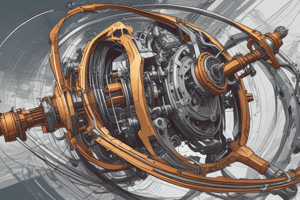Podcast
Questions and Answers
What is the definition of pressure?
What is the definition of pressure?
- Weight of a substance per volume
- Force per unit area (correct)
- Density multiplied by acceleration
- Volume per unit mass
Which factor does NOT affect the pressure exerted by a column of fluid in an open container?
Which factor does NOT affect the pressure exerted by a column of fluid in an open container?
- Gravity
- Density of the fluid
- Volume of the liquid (correct)
- Vertical height of the column
In the context of gases, what happens to the molecules when a substance is heated?
In the context of gases, what happens to the molecules when a substance is heated?
- They become denser and heavier
- They slow down and clump together
- They escape from the container completely
- They move around more rapidly (correct)
Which statement about liquids and gases is accurate?
Which statement about liquids and gases is accurate?
How is the pressure of Block A calculated, given it has a force of 1000 N acting over an area of 4 m²?
How is the pressure of Block A calculated, given it has a force of 1000 N acting over an area of 4 m²?
What remains constant in a liquid despite changes in pressure?
What remains constant in a liquid despite changes in pressure?
What typically does not occur when gas molecules collide with a container's walls?
What typically does not occur when gas molecules collide with a container's walls?
What is the correct relationship represented by density?
What is the correct relationship represented by density?
What must be done to rectify an unbalanced rotating component?
What must be done to rectify an unbalanced rotating component?
What happens when a propeller is perfectly balanced?
What happens when a propeller is perfectly balanced?
Which of the following is not commonly balanced during manufacturing?
Which of the following is not commonly balanced during manufacturing?
What is the formula for calculating stress on an object?
What is the formula for calculating stress on an object?
According to Hooke's Law, what happens if the stress applied to a material is doubled?
According to Hooke's Law, what happens if the stress applied to a material is doubled?
What does strain measure in relation to a material?
What does strain measure in relation to a material?
Which condition leads to excessive vibration in a high-speed rotating component?
Which condition leads to excessive vibration in a high-speed rotating component?
What will happen if the strain exceeds a material's elastic limit?
What will happen if the strain exceeds a material's elastic limit?
What type of stress develops in the direction opposite to the twist during torsion?
What type of stress develops in the direction opposite to the twist during torsion?
What phenomenon often leads to internal stress during heat treatment of metals?
What phenomenon often leads to internal stress during heat treatment of metals?
Fatigue failure in components is primarily caused by which of the following?
Fatigue failure in components is primarily caused by which of the following?
What is a common initiating point for a fatigue crack in materials?
What is a common initiating point for a fatigue crack in materials?
Which of the following is considered a 'stress raiser' that can lead to fatigue failure?
Which of the following is considered a 'stress raiser' that can lead to fatigue failure?
Residual stress can be beneficial in which scenario?
Residual stress can be beneficial in which scenario?
What type of failures are fatigue failures compared to overload failures?
What type of failures are fatigue failures compared to overload failures?
What process can lead to the formation of internal stress in materials?
What process can lead to the formation of internal stress in materials?
Which of the following statements accurately describes a force?
Which of the following statements accurately describes a force?
What is required for a vector to be fully defined?
What is required for a vector to be fully defined?
What is the correct process for adding vectors?
What is the correct process for adding vectors?
Which of the following best describes a scalar quantity?
Which of the following best describes a scalar quantity?
Which type of stress is defined as a force that tends to stretch a material?
Which type of stress is defined as a force that tends to stretch a material?
What is a couple in terms of forces?
What is a couple in terms of forces?
Which factor is essential to calculate pressure in a fluid?
Which factor is essential to calculate pressure in a fluid?
In which scenario does buoyancy act on an object?
In which scenario does buoyancy act on an object?
What determines atmospheric pressure at a given location?
What determines atmospheric pressure at a given location?
How is absolute pressure calculated?
How is absolute pressure calculated?
What is the differential pressure experienced by an aircraft cruising at 29,000 ft with an outside pressure of 4.4 psi and an internal cabin pressure of 11 psi?
What is the differential pressure experienced by an aircraft cruising at 29,000 ft with an outside pressure of 4.4 psi and an internal cabin pressure of 11 psi?
Which statement correctly describes solids?
Which statement correctly describes solids?
What characteristic does a fluid have at any point on the surface of a submerged object?
What characteristic does a fluid have at any point on the surface of a submerged object?
Which type of pressure reading is displayed on a tire pressure gauge?
Which type of pressure reading is displayed on a tire pressure gauge?
What describes the properties of solids compared to liquids and gases?
What describes the properties of solids compared to liquids and gases?
What happens to the atmospheric pressure as altitude increases?
What happens to the atmospheric pressure as altitude increases?
What does the velocity ratio indicate in a pulley system with a mechanical advantage (MA) of 4?
What does the velocity ratio indicate in a pulley system with a mechanical advantage (MA) of 4?
What is a 'couple' in terms of forces and moments?
What is a 'couple' in terms of forces and moments?
How is the torque produced by a couple calculated?
How is the torque produced by a couple calculated?
What defines the Centre of Gravity (CG) of an object?
What defines the Centre of Gravity (CG) of an object?
How can the Centre of Gravity (CG) be determined for an irregularly shaped solid?
How can the Centre of Gravity (CG) be determined for an irregularly shaped solid?
When an object is suspended, where does it tend to position itself?
When an object is suspended, where does it tend to position itself?
What characteristic does the CG of uniformly dense regular-shaped bodies have?
What characteristic does the CG of uniformly dense regular-shaped bodies have?
What is true about the weight of a body concerning its Centre of Gravity?
What is true about the weight of a body concerning its Centre of Gravity?
Flashcards
Pressure in Liquids/Gases
Pressure in Liquids/Gases
Force per unit area exerted by a fluid (liquid or gas).
Fluid
Fluid
A substance that can flow, including liquids and gases.
Incompressible Fluid
Incompressible Fluid
A fluid with constant density (e.g., liquid).
Compressible Fluid
Compressible Fluid
Signup and view all the flashcards
Pressure in a fluid column
Pressure in a fluid column
Signup and view all the flashcards
Density
Density
Signup and view all the flashcards
Specific Gravity
Specific Gravity
Signup and view all the flashcards
Pressure = Force/Area
Pressure = Force/Area
Signup and view all the flashcards
Balancing Rotating Components
Balancing Rotating Components
Signup and view all the flashcards
Mass Balancing
Mass Balancing
Signup and view all the flashcards
Stress
Stress
Signup and view all the flashcards
Strain
Strain
Signup and view all the flashcards
Elasticity
Elasticity
Signup and view all the flashcards
Elastic Limit
Elastic Limit
Signup and view all the flashcards
Hooke's Law
Hooke's Law
Signup and view all the flashcards
High-Speed Rotating Components
High-Speed Rotating Components
Signup and view all the flashcards
Force
Force
Signup and view all the flashcards
Vector
Vector
Signup and view all the flashcards
Scalar
Scalar
Signup and view all the flashcards
Vector Addition
Vector Addition
Signup and view all the flashcards
Resultant
Resultant
Signup and view all the flashcards
Magnitude
Magnitude
Signup and view all the flashcards
Direction
Direction
Signup and view all the flashcards
Simple machines
Simple machines
Signup and view all the flashcards
Velocity Ratio
Velocity Ratio
Signup and view all the flashcards
Mechanical Advantage (MA)
Mechanical Advantage (MA)
Signup and view all the flashcards
What is a 'couple' in mechanics?
What is a 'couple' in mechanics?
Signup and view all the flashcards
Centre of Gravity (CG)
Centre of Gravity (CG)
Signup and view all the flashcards
How to find the CG of an irregular shape
How to find the CG of an irregular shape
Signup and view all the flashcards
Weight acts through the CG
Weight acts through the CG
Signup and view all the flashcards
Residual Stress
Residual Stress
Signup and view all the flashcards
Fatigue Failure
Fatigue Failure
Signup and view all the flashcards
Stress Raisers
Stress Raisers
Signup and view all the flashcards
Twisting Stress
Twisting Stress
Signup and view all the flashcards
Compression Stress
Compression Stress
Signup and view all the flashcards
Tension Stress
Tension Stress
Signup and view all the flashcards
Fatigue failure locations
Fatigue failure locations
Signup and view all the flashcards
Preventing Fatigue Failure
Preventing Fatigue Failure
Signup and view all the flashcards
Atmospheric Pressure
Atmospheric Pressure
Signup and view all the flashcards
Absolute Pressure
Absolute Pressure
Signup and view all the flashcards
Gauge Pressure
Gauge Pressure
Signup and view all the flashcards
Differential Pressure
Differential Pressure
Signup and view all the flashcards
Solids
Solids
Signup and view all the flashcards
Force on a Submerged Object
Force on a Submerged Object
Signup and view all the flashcards
What makes Solids hold their shape?
What makes Solids hold their shape?
Signup and view all the flashcards
Study Notes
Module: B-2 Physics, Topic 2.2.1 Statics
- Statics covers forces, moments, couples, and their interaction
- Simple machines and mechanical advantage are part of this topic
- The center of gravity of a mass is described
- Concepts of stress, strain, and elasticity are explored, including tension, compression, shear, and torsion
- Solids, fluids, and gases are discussed, along with their properties
- The action of pressure and buoyancy in liquids is explored using barometers
- Force is defined as that which produces change in a body's state of motion
- Force can start, stop, accelerate, or decelerate a mass
- Force can be used to do work if energy is available
- Vectors need both magnitude (size) and direction for full definition
- Scalars are defined by magnitude only (e.g., temperature, length, time)
- Vector addition involves placing one vector's tail at the head of another, then connecting the tail of the first vector to the head of the second vector
- Resolving a vector involves finding its components (horizontal and vertical) using trigonometric ratios
- Equilibrium occurs when the resultant force of all forces acting on an object is zero, meaning the object's state of motion or rest isn't altered
- Moments are the product of force and the distance from a fulcrum
- Levers are simple machines used to perform work by moving a load using an effort, pivoting around a fulcrum
- There are three main classes of levers (first, second, and third class).
- First-class levers have the fulcrum between the load and the effort; a crowbar is an example.
- Second-class levers have the load between the fulcrum and the effort; a wheelbarrow is an example.
- Third-class levers have the effort between the fulcrum and the load; ice tongs are an example. -Mechanical advantage (MA) is the ratio of the load to the effort
- A velocity ratio relates the speeds at which a system's inputs and outputs operate
- A couple is a moment produced by two equal but opposite forces acting on a body around an axis, causing torque or twisting
- The center of gravity (CG) of a body is the point where its weight acts, regardless of its position
- Uniformly dense, regularly shaped objects have their CG at their geometric center
- Irregularly shaped objects have their CG found by suspending the object from multiple points, using the intersection of the vertical lines as the CG
- The entire weight of a body acts vertically through the center of gravity
- Shifting the center of gravity influences how the body will stay balanced
- Objects of regular shape, like discs and wheels can be balanced, but factors like variation in density, structure or wear may disrupt their center of gravity requiring adjustment
- Fatigue is caused by repeated loads over time, leading to failure
- Damage or changes in shape or thickness can cause stress concentration points, predisposing an object to failure.
- Buoyancy and pressure in liquids and gases are similar
- Liquids are considered incompressible; gases are compressible
- Pressure is defined as force per unit area
- Atmospheric pressure changes based on the weight of air above a location
- Gauge pressure is relative (above or below atmospheric pressure)
- Absolute pressure is the gauge pressure + atmospheric pressure
Studying That Suits You
Use AI to generate personalized quizzes and flashcards to suit your learning preferences.





